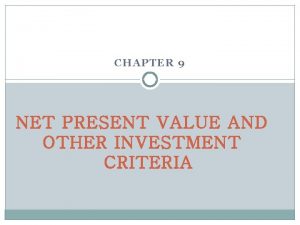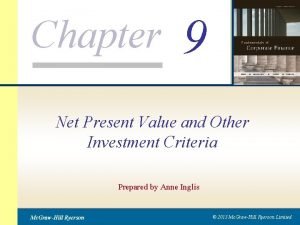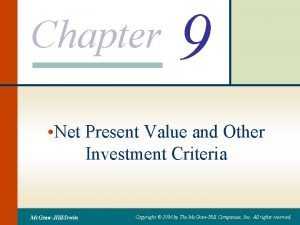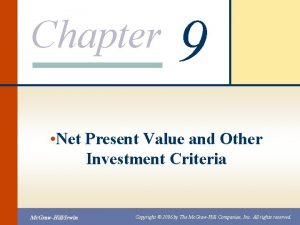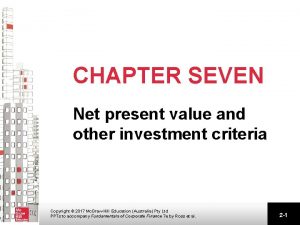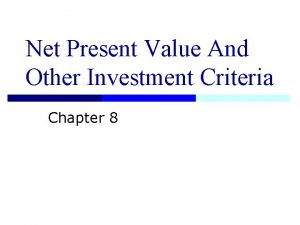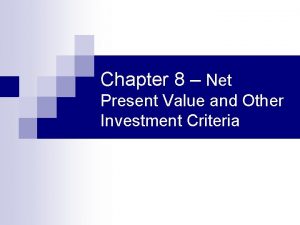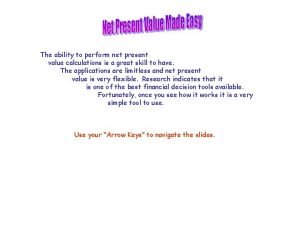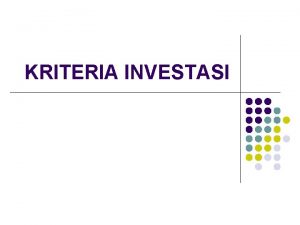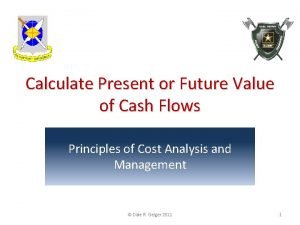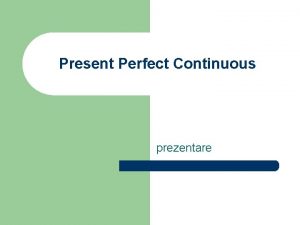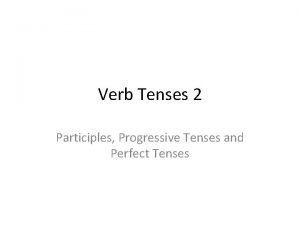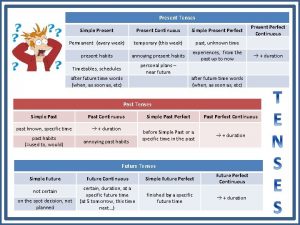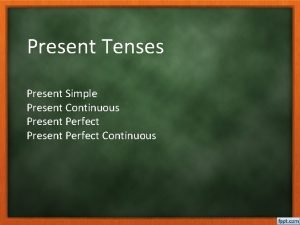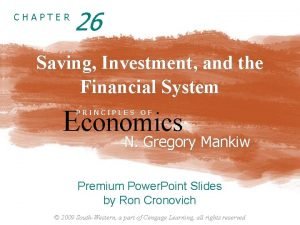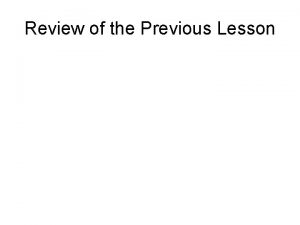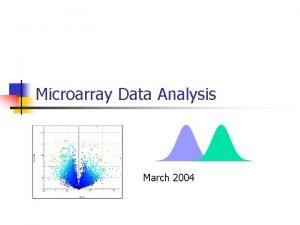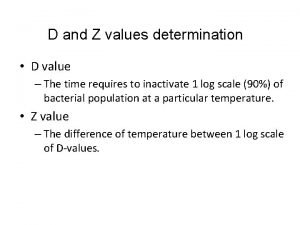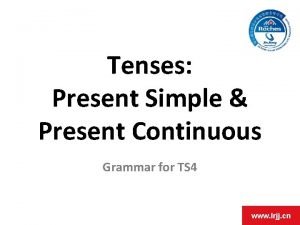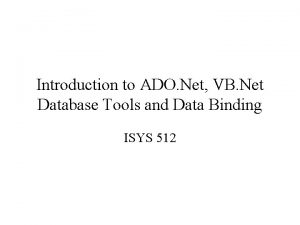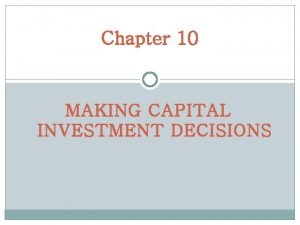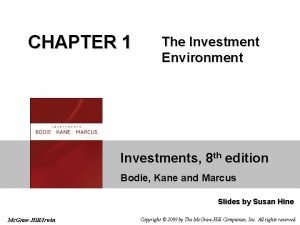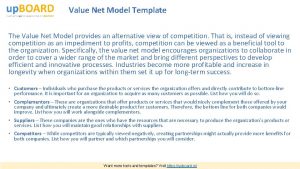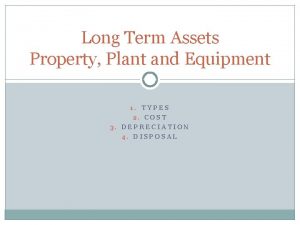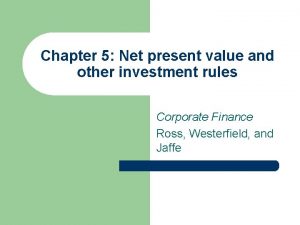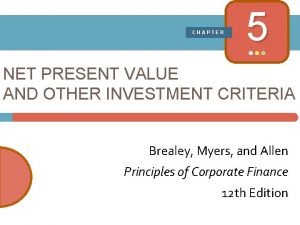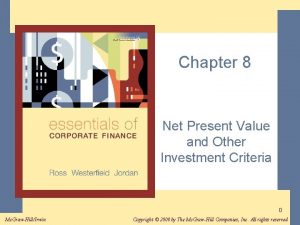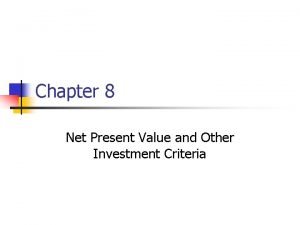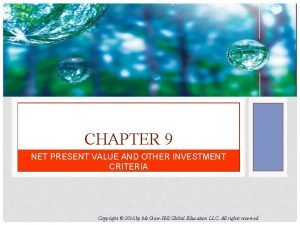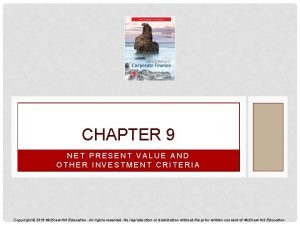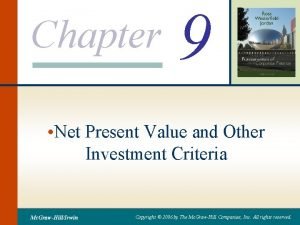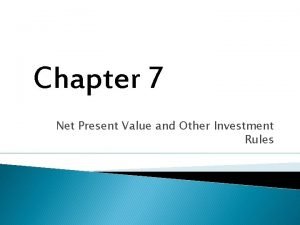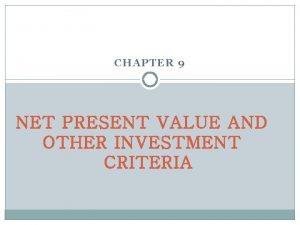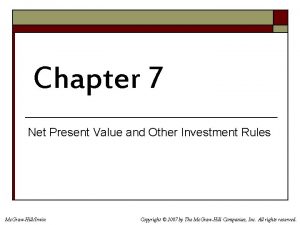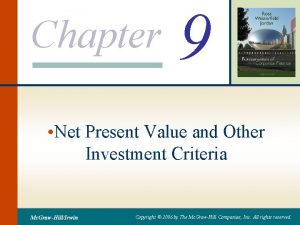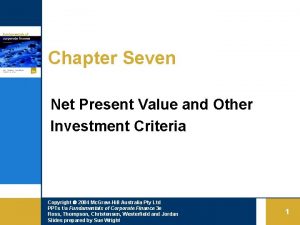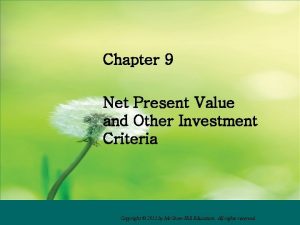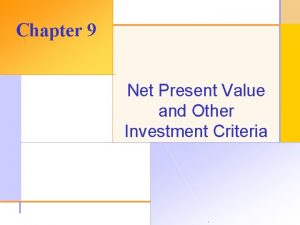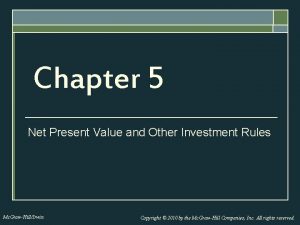Chapter 9 Net Present Value and Other Investment











































- Slides: 43

Chapter 9 Net Present Value and Other Investment Criteria Prepared by Anne Inglis Mc. Graw-Hill Ryerson © 2013 Mc. Graw-Hill Ryerson Limited

Key Concepts and Skills • Be able to compute the net present value and understand why it is the best decision criterion • Be able to compute payback and discounted payback and understand their shortcomings • Understand accounting rates of return and their shortcomings • Be able to compute the internal rate of return and understand its strengths and weaknesses • Understand the modified internal rate of return • Understand the profitability index and its relation to net present value © 2013 Mc. Graw-Hill Ryerson Limited 9 -1

Chapter Outline • • • Net Present Value The Payback Rule The Discounted Payback The Average Accounting Return The Internal Rate of Return The Profitability Index The Practice of Capital Budgeting Summary and Conclusions Appendix A – Modified Internal Rate of Return © 2013 Mc. Graw-Hill Ryerson Limited 9 -2

All LOs What Makes a Good Decision Criteria? • We need to ask ourselves the following questions when evaluating decision criteria • Does the decision rule adjust for the time value of money? • Does the decision rule adjust for risk? • Does the decision rule provide information on whether we are creating value for the firm? © 2013 Mc. Graw-Hill Ryerson Limited 9 -3

All LOs Project Example Information • You are looking at a new project and you have estimated the following cash flows: • • Year 0: Year 1: Year 2: Year 3: CF = -165, 000 CF = 63, 120 CF = 70, 800 CF = 91, 080 • Your required return for assets of this risk is 12%. © 2013 Mc. Graw-Hill Ryerson Limited 9 -4

LO 1 Net Present Value 9. 1 • The difference between the market value of a project and its cost • How much value is created from undertaking an investment? • The first step is to estimate the expected future cash flows. • The second step is to estimate the required return for projects of this risk level. • The third step is to find the present value of the cash flows and subtract the initial investment. © 2013 Mc. Graw-Hill Ryerson Limited 9 -5

LO 1 NPV – Decision Rule • If the NPV is positive, accept the project • A positive NPV means that the project is expected to add value to the firm and will therefore increase the wealth of the owners. • Since our goal is to increase owner wealth, NPV is a direct measure of how well this project will meet our goal. © 2013 Mc. Graw-Hill Ryerson Limited 9 -6

LO 1 Computing NPV for the Project • Using the formulas: • NPV = 63, 120/(1. 12) + 70, 800/(1. 12)2 + 91, 080/(1. 12)3 – 165, 000 = 12, 627. 42 • Do we accept or reject the project? © 2013 Mc. Graw-Hill Ryerson Limited 9 -7

LO 1 Decision Criteria Test - NPV • Does the NPV rule account for the time value of money? • Does the NPV rule account for the risk of the cash flows? • Does the NPV rule provide an indication about the increase in value? • Should we consider the NPV rule for our primary decision criteria? © 2013 Mc. Graw-Hill Ryerson Limited 9 -8

LO 1 Calculating NPVs with a Spreadsheet • Spreadsheets are an excellent way to compute NPVs. • Using the NPV function • The first component is the required return entered as a decimal • The second component is the range of cash flows beginning with year 1 • Subtract the initial investment after computing the NPV © 2013 Mc. Graw-Hill Ryerson Limited 9 -9

LO 2 Payback Period 9. 2 • How long does it take to get the initial cost back in a nominal sense? • Computation • Estimate the cash flows • Subtract the future cash flows from the initial cost until the initial investment has been recovered • Decision Rule – Accept if the payback period is less than some preset limit © 2013 Mc. Graw-Hill Ryerson Limited 9 -10

LO 2 Computing Payback For The Project • Assume we will accept the project if it pays back within two years. • Year 1: 165, 000 – 63, 120 = 101, 880 still to recover • Year 2: 101, 880 – 70, 800 = 31, 080 still to recover • Year 3: 31, 080 – 91, 080 = -60, 000 project pays back in year 3 • If the preset limit is 3 years, do we accept or reject the project? © 2013 Mc. Graw-Hill Ryerson Limited 9 -11

LO 2 Decision Criteria Test - Payback • Does the payback rule account for the time value of money? • Does the payback rule account for the risk of the cash flows? • Does the payback rule provide an indication about the increase in value? • Should we consider the payback rule for our primary decision criteria? © 2013 Mc. Graw-Hill Ryerson Limited 9 -12

LO 2 Advantages and Disadvantages of Payback • Advantages • Disadvantages • Easy to understand • Adjusts for uncertainty of later cash flows • Biased towards liquidity • Ignores the time value of money • Requires an arbitrary cutoff point • Ignores cash flows beyond the cutoff date • Biased against longterm projects, such as research and development, and new projects © 2013 Mc. Graw-Hill Ryerson Limited 9 -13

LO 3 Discounted Payback Period • Compute the present value of each cash flow and then determine how long it takes to payback on a discounted basis • Compare to a specified required payback period • Decision Rule - Accept the project if it pays back on a discounted basis within the specified time © 2013 Mc. Graw-Hill Ryerson Limited 9 -14

LO 3 Computing Discounted Payback for the Project • Assume we will accept the project if it pays back on a discounted basis in 2 years. • Compute the PV for each cash flow and determine the payback period using discounted cash flows • Year 1: 165, 000 – 63, 120/1. 121 = 108, 643 • Year 2: 108, 643 – 70, 800/1. 122 = 52, 202 • Year 3: 52, 202 – 91, 080/1. 123 = -12, 627 project pays back in year 3 • Do we accept or reject the project? © 2013 Mc. Graw-Hill Ryerson Limited 9 -15

LO 3 Decision Criteria Test – Discounted Payback • Does the discounted payback rule account for the time value of money? • Does the discounted payback rule account for the risk of the cash flows? • Does the discounted payback rule provide an indication about the increase in value? • Should we consider the discounted payback rule for our primary decision criteria? © 2013 Mc. Graw-Hill Ryerson Limited 9 -16

LO 3 Advantages and Disadvantages of Discounted Payback • Advantages • Disadvantages • Includes time value of money • Easy to understand • Does not accept negative estimated NPV investments • Biased towards liquidity • May reject positive NPV investments • Requires an arbitrary cutoff point • Ignores cash flows beyond the cutoff date • Biased against longterm projects, such as R&D, and new projects © 2013 Mc. Graw-Hill Ryerson Limited 9 -17

LO 5 Internal Rate of Return 9. 4 • This is the most important alternative to NPV • It is often used in practice and is intuitively appealing • It is based entirely on the estimated cash flows and is independent of interest rates found elsewhere © 2013 Mc. Graw-Hill Ryerson Limited 9 -18

LO 5 IRR – Definition and Decision Rule • Definition: IRR is the return that makes the NPV = 0 • Decision Rule: Accept the project if the IRR is greater than the required return © 2013 Mc. Graw-Hill Ryerson Limited 9 -19

LO 5 Computing IRR For The Project • If you do not have a financial calculator, then this becomes a trial and error process • Calculator • Enter the cash flows as you did with NPV • Press IRR and then CPT • IRR = 16. 13% > 12% required return • Do we accept or reject the project? © 2013 Mc. Graw-Hill Ryerson Limited 9 -20

LO 5 NPV Profile For The Project IRR = 16. 13% © 2013 Mc. Graw-Hill Ryerson Limited 9 -21

LO 5 Calculating IRRs With A Spreadsheet • You start with the cash flows the same as you did for the NPV • You use the IRR function • You first enter your range of cash flows, beginning with the initial cash flow • You can enter a guess, but it is not necessary • The default format is a whole percent – you will normally want to increase the decimal places to at least two © 2013 Mc. Graw-Hill Ryerson Limited 9 -22

LO 5 Decision Criteria Test - IRR • Does the IRR rule account for the time value of money? • Does the IRR rule account for the risk of the cash flows? • Does the IRR rule provide an indication about the increase in value? • Should we consider the IRR rule for our primary decision criteria? © 2013 Mc. Graw-Hill Ryerson Limited 9 -23

LO 5 Advantages of IRR • Knowing a return is intuitively appealing • It is a simple way to communicate the value of a project to someone who doesn’t know all the estimation details • If the IRR is high enough, you may not need to estimate a required return, which is often a difficult task • Generally leads to the same answers as the NPV method © 2013 Mc. Graw-Hill Ryerson Limited 9 -24

LO 5 Disadvantages of IRR • NPV and IRR will generally give us the same decision • Exceptions: • May result in multiple answers or no answer with non-conventional cash flows • May lead to incorrect decisions in comparisons of mutually exclusive investments © 2013 Mc. Graw-Hill Ryerson Limited 9 -25

LO 5 IRR and Non-conventional Cash Flows • When the cash flows change sign more than once, there is more than one IRR • When you solve for the IRR, you are solving for the root of an equation. When you cross the x-axis more than once, there will be more than one return that solves the equation • If you have more than one IRR, which one do you use to make your decision? © 2013 Mc. Graw-Hill Ryerson Limited 9 -26

LO 5 Another Example – Nonconventional Cash Flows • Suppose an investment will cost $90, 000 initially and will generate the following cash flows: • Year 1: 132, 000 • Year 2: 100, 000 • Year 3: -150, 000 • The required return is 15%. • Should we accept or reject the project? © 2013 Mc. Graw-Hill Ryerson Limited 9 -27

LO 5 NPV Profile IRR = 10. 11% and 42. 66% © 2013 Mc. Graw-Hill Ryerson Limited 9 -28

LO 5 Summary of Decision Rules • The NPV is positive at a required return of 15%, so you should Accept • If you use the financial calculator, you would get an IRR of 10. 11% which would tell you to Reject • You need to recognize that there are nonconventional cash flows and look at the NPV profile © 2013 Mc. Graw-Hill Ryerson Limited 9 -29

LO 5 IRR and Mutually Exclusive Projects • Mutually exclusive projects • If you choose one, you can’t choose the other • Example: You can choose to attend graduate school next year at either Harvard or Stanford, but not both • Intuitively you would use the following decision rules: • NPV – choose the project with the higher NPV • IRR – choose the project with the higher IRR © 2013 Mc. Graw-Hill Ryerson Limited 9 -30

LO 5 Example With Mutually Exclusive Projects Period Project A Project B 0 -500 -400 1 325 200 IRR 19. 43% 22. 17% NPV 64. 05 60. 74 The required return for both projects is 10%. Which project should you accept and why? © 2013 Mc. Graw-Hill Ryerson Limited 9 -31

LO 5 NPV Profiles IRR for A = 19. 43% IRR for B = 22. 17% Crossover Point = 11. 8% © 2013 Mc. Graw-Hill Ryerson Limited 9 -32

LO 5 Conflicts Between NPV and IRR • NPV directly measures the increase in value to the firm • Whenever there is a conflict between NPV and another decision rule, you should always use NPV • IRR is unreliable in the following situations • Non-conventional cash flows • Mutually exclusive projects © 2013 Mc. Graw-Hill Ryerson Limited 9 -33

LO 7 Profitability Index 9. 5 • Measures the benefit per unit cost, based on the time value of money • A profitability index of 1. 1 implies that for every $1 of investment, we create an additional $0. 10 in value • This measure can be very useful in situations where we have limited capital © 2013 Mc. Graw-Hill Ryerson Limited 9 -34

LO 7 Advantages and Disadvantages of Profitability Index • Advantages • Disadvantages • Closely related to NPV, generally leading to identical decisions • Easy to understand communicate • May be useful when available investment funds are limited • May lead to incorrect decisions in comparisons of mutually exclusive investments © 2013 Mc. Graw-Hill Ryerson Limited 9 -35

All LOs The Practice of Capital Budgeting 9. 6 • NPV and IRR are the most commonly used primary investment criteria • Payback is a commonly used secondary investment criteria • Capital budgeting techniques vary with industry. • Firms that are better able to estimate cash flows precisely are more likely to use NPV © 2013 Mc. Graw-Hill Ryerson Limited 9 -36

Quick Quiz • Consider an investment that costs $100, 000 and has a cash inflow of $25, 000 every year for 5 years. The required return is 9% and required payback is 4 years. • • What is the payback period? What is the NPV? What is the IRR? Should we accept the project? • What decision rule should be the primary decision method? • When is the IRR rule unreliable? © 2013 Mc. Graw-Hill Ryerson Limited 9 -37

Summary 9. 7 • Net Present Value • • Difference between market value and cost Take the project if the NPV is positive Has no serious problems Preferred decision criterion © 2013 Mc. Graw-Hill Ryerson Limited 9 -38

Summary continued • Internal Rate of Return • Discount rate that makes NPV = 0 • Take the project if the IRR is greater than required return • Same decision as NPV with conventional cash flows • IRR is unreliable with non-conventional cash flows or mutually exclusive projects © 2013 Mc. Graw-Hill Ryerson Limited 9 -39

Summary continued • Profitability Index • • Benefit-cost ratio Take investment if PI > 1 Cannot be used to rank mutually exclusive projects May be used to rank projects in the presence of capital rationing • Payback Period • Length of time until initial investment is recovered • Take the project if it pays back in some specified period • Doesn’t account for time value of money and there is an arbitrary cutoff period © 2013 Mc. Graw-Hill Ryerson Limited 9 -40

Summary continued • Discounted Payback Period • Length of time until initial investment is recovered on a discounted basis • Take the project if it pays back in some specified period • There is an arbitrary cutoff period © 2013 Mc. Graw-Hill Ryerson Limited 9 -41

Homework • 7, 8, 12, 16 9 -42
 Chapter 9 net present value and other investment criteria
Chapter 9 net present value and other investment criteria Net present value and other investment criteria
Net present value and other investment criteria Chapter 9 net present value and other investment criteria
Chapter 9 net present value and other investment criteria Chapter 9 net present value and other investment criteria
Chapter 9 net present value and other investment criteria Net present value of investment
Net present value of investment Fixed investment and inventory investment
Fixed investment and inventory investment Apa itu value creation
Apa itu value creation What is the formula for profitability index
What is the formula for profitability index Net present value explained
Net present value explained Npv meaning
Npv meaning Npv meaning
Npv meaning Net present value assumptions
Net present value assumptions Net present value
Net present value Kriteria npv
Kriteria npv Present value table
Present value table Present simple present continuous and present perfect
Present simple present continuous and present perfect Value line investment survey
Value line investment survey Other initiated self repair example
Other initiated self repair example I write a letter now past continuous tense
I write a letter now past continuous tense Present perfect continuous affirmative
Present perfect continuous affirmative Present perfect continuous schema
Present perfect continuous schema Which verb tenses describe continuing action?
Which verb tenses describe continuing action? I do i did
I do i did Present simple present continuous present perfect
Present simple present continuous present perfect Chapter 6 theories of international trade and investment
Chapter 6 theories of international trade and investment Chapter 26 saving investment and the financial system
Chapter 26 saving investment and the financial system Valrox
Valrox T test p value interpretation
T test p value interpretation D value and z value
D value and z value Acetyl value principle
Acetyl value principle Creating value and capturing value
Creating value and capturing value Difference between present simple and present continuous
Difference between present simple and present continuous Achmed lach net ich krieg mein tach net
Achmed lach net ich krieg mein tach net Ado.net vb.net
Ado.net vb.net Chapter 1 the investment environment
Chapter 1 the investment environment Chapter 17 intermediate accounting
Chapter 17 intermediate accounting Tax shield formula
Tax shield formula Afnan hossain
Afnan hossain Chapter 10 making capital investment decisions
Chapter 10 making capital investment decisions Chapter 1 the investment environment
Chapter 1 the investment environment The value net framework
The value net framework Net realizable value
Net realizable value Useful life of property plant and equipment
Useful life of property plant and equipment Net realizable value formula
Net realizable value formula
